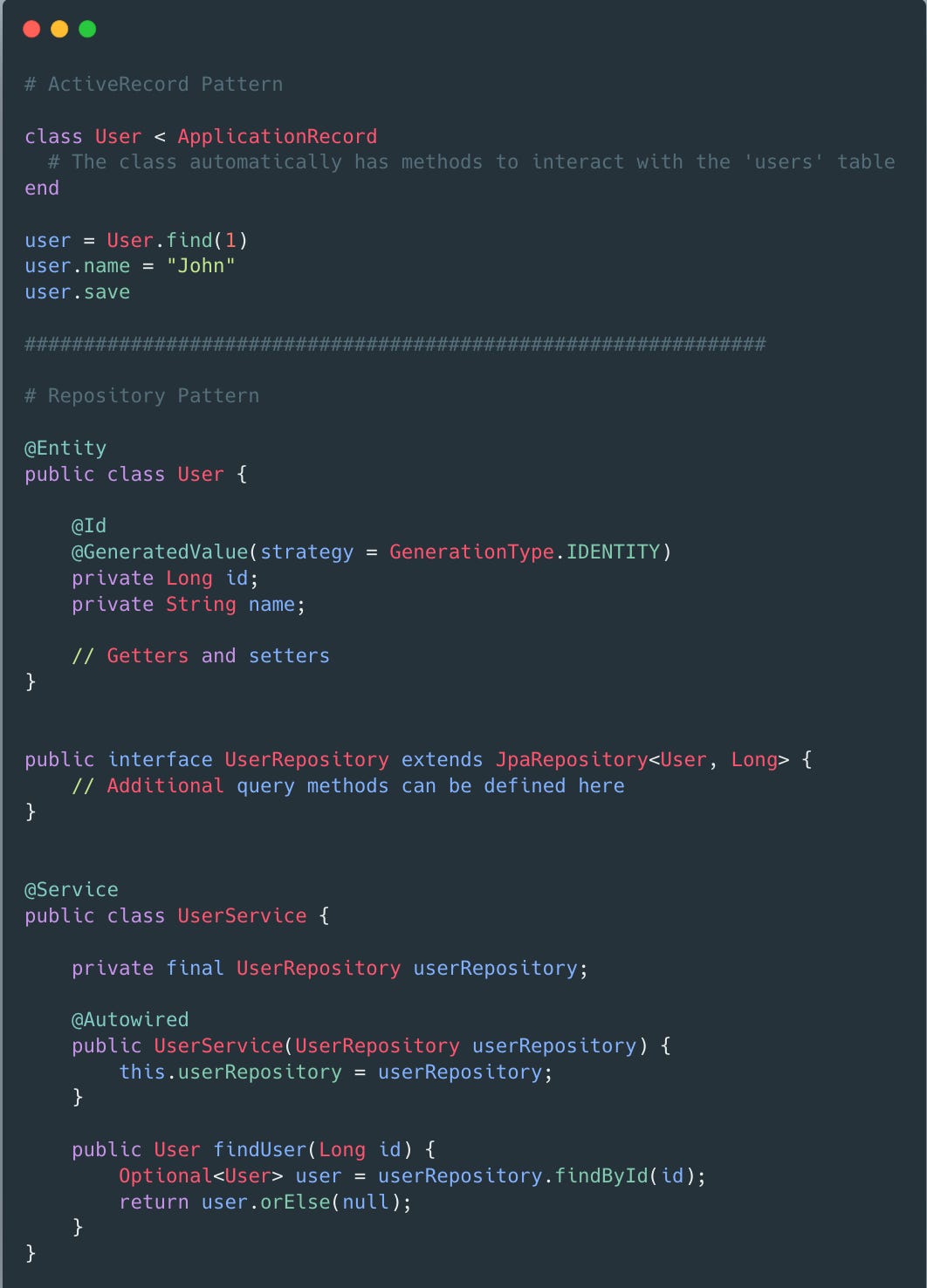Active Record vs. Repository Pattern
Choosing the Right Data Access Pattern for Your Java Application
Introduction
When working with databases in object-oriented programming, two common patterns are the Active Record and Repository patterns. Here’s a comparison of both.
Active Record Pattern
Overview:
The Active Record pattern is an architectural pattern found in many web frameworks. In this pattern, objects are responsible for their own data and the methods to manipulate it, including saving and retrieving from the database.
Key Features:
Direct Mapping: Each class maps directly to a database table, and each instance corresponds to a row.
Integrated Data Access: The class contains methods for CRUD (Create, Read, Update, Delete) operations.
Simplicity: It’s straightforward to use and is well-suited for simple applications with relatively straightforward business logic.
Advantages:
Ease of Use: Active Record is often easier to use for basic CRUD operations since it combines data access and business logic.
Convention Over Configuration: Many frameworks (like Rails) offer conventions that reduce the amount of configuration required.
Quicker Development: The integrated approach can speed up development for simple applications.
Disadvantages:
Tight Coupling: The model is tightly coupled to the database schema, making it harder to change the database without affecting the model.
Single Responsibility Principle Violation: Combining data access and business logic in one class can lead to bloated models.
Complexity in Large Applications: For complex business logic or large applications, the Active Record pattern can become unwieldy.
class User < ApplicationRecord
# The class automatically has methods to interact with the 'users' table
end
user = User.find(1)
user.name = "John"
user.saveRepository Pattern
Overview:
The Repository pattern separates the business logic and the data access logic. It acts as a mediator between the domain and data mapping layers, using a collection-like interface for accessing domain objects.
Key Features:
Decoupling: The pattern decouples the data access logic from the business logic, promoting a clean separation of concerns.
Testability: Mocking repositories in unit tests is easier, improving testability.
Flexibility: It provides greater flexibility in terms of changing data sources or structures without affecting business logic.
Advantages:
Separation of Concerns: Data access logic is separate from business logic, adhering to the Single Responsibility Principle.
Easier Testing: The pattern allows for better isolation of business logic from data access, making it easier to write unit tests.
Flexibility and Maintainability: Changing the data access layer (e.g., switching from a relational database to a NoSQL database) requires minimal changes to the business logic.
Disadvantages:
Complexity: The pattern adds an extra layer of abstraction, which can increase the complexity of the codebase.
Slower Development: It may slow down development due to the additional layers and interfaces that need to be defined.
@Entity
public class User {
@Id
@GeneratedValue(strategy = GenerationType.IDENTITY)
private Long id;
private String name;
// Getters and setters
}
public interface UserRepository extends JpaRepository<User, Long> {
// Additional query methods can be defined here
}
@Service
public class UserService {
private final UserRepository userRepository;
@Autowired
public UserService(UserRepository userRepository) {
this.userRepository = userRepository;
}
public User findUser(Long id) {
Optional<User> user = userRepository.findById(id);
return user.orElse(null);
}
public void saveUser(User user) {
userRepository.save(user);
}
}Conclusion
The choice between the Active Record and Repository patterns in a Java application using Spring Data JPA depends on the complexity and requirements of your project.
Active Record Pattern:
Pros: Simplicity and ease of use for basic CRUD operations.
Cons: Tight coupling between data and business logic, making it harder to maintain and test in large applications.
Use Case: Best suited for simple applications with straightforward business logic.
Repository Pattern:
Pros: Separation of concerns, improved testability, and flexibility in changing data sources.
Cons: Adds an extra layer of abstraction, which can increase the initial complexity.
Use Case: Ideal for complex applications where maintainability, scalability, and testability are critical.
If you are interested in sponsoring this newsletter , reach out to surajmishra150893@gmail.com. Basic details can be found here.
Connect with me, LinkedIn | Twitter. If you have any questions related to SWE/Career, etc, don’t hesitate to DM me. I would love to help my fellow SWEs using my 9 years of experience working in fintech across different countries. ( India/Japan/US/Canada )


